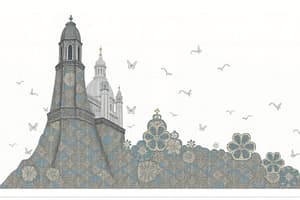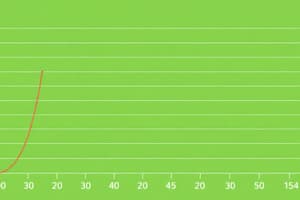Podcast
Questions and Answers
Which chamber of the heart is responsible for pumping oxygenated blood to the rest of the body?
Which chamber of the heart is responsible for pumping oxygenated blood to the rest of the body?
- Right atrium
- Right ventricle
- Left atrium
- Left ventricle (correct)
The apex of the heart is located at the top, where the great vessels attach.
The apex of the heart is located at the top, where the great vessels attach.
False (B)
What is the name of the muscular wall that separates the right and left ventricles?
What is the name of the muscular wall that separates the right and left ventricles?
Interventricular septum
The ______ is the front part of the heart.
The ______ is the front part of the heart.
Match the following terms with their corresponding descriptions:
Match the following terms with their corresponding descriptions:
Which chamber of the heart receives deoxygenated blood from the superior and inferior vena cava?
Which chamber of the heart receives deoxygenated blood from the superior and inferior vena cava?
The left ventricle pumps deoxygenated blood to the body.
The left ventricle pumps deoxygenated blood to the body.
What is the name of the thick wall that separates the right and left sides of the heart, preventing mixing of oxygenated and deoxygenated blood?
What is the name of the thick wall that separates the right and left sides of the heart, preventing mixing of oxygenated and deoxygenated blood?
The ______ valve regulates blood flow between the right atrium and the right ventricle.
The ______ valve regulates blood flow between the right atrium and the right ventricle.
Match the heart chamber with its function:
Match the heart chamber with its function:
Which chamber of the heart has the thickest muscular wall?
Which chamber of the heart has the thickest muscular wall?
The left atrium receives deoxygenated blood from the lungs.
The left atrium receives deoxygenated blood from the lungs.
What is the role of the valves in the heart?
What is the role of the valves in the heart?
Flashcards
Box Diagram of the Heart
Box Diagram of the Heart
A schematic representation depicting the heart's structure and blood flow.
Right Atrium
Right Atrium
Top-right chamber that receives deoxygenated blood from the body via the vena cava.
Right Ventricle
Right Ventricle
Lower-right chamber that pumps deoxygenated blood to the lungs for oxygenation.
Left Atrium
Left Atrium
Signup and view all the flashcards
Blood Flow Direction
Blood Flow Direction
Signup and view all the flashcards
Septum
Septum
Signup and view all the flashcards
Heart Valves
Heart Valves
Signup and view all the flashcards
Pulmonary Artery
Pulmonary Artery
Signup and view all the flashcards
Left Ventricle
Left Ventricle
Signup and view all the flashcards
Base of the Heart
Base of the Heart
Signup and view all the flashcards
Apex of the Heart
Apex of the Heart
Signup and view all the flashcards
Study Notes
Box Diagram of the Heart
- A box diagram (or box-and-points diagram) visually represents the heart and its key structures.
- It simplifies the heart, highlighting chambers (atria and ventricles) and major vessels (like the aorta and vena cava).
- It's a simplified illustration, focusing on connections between heart parts and blood vessels, not precise anatomy.
- A good box diagram displays blood flow: vena cava/pulmonary veins to atria, atria to ventricles, ventricles to pulmonary arteries (right) and aorta (left), showcasing pulmonary and systemic loops.
Areas of the Heart
- The heart's different areas relate to specific structures and functions.
- The right atrium receives deoxygenated blood from the body via the superior and inferior vena cava.
- The right ventricle pumps this deoxygenated blood to the lungs through the pulmonary artery.
- The left atrium receives oxygenated blood from the lungs through the pulmonary veins.
- The left ventricle pumps oxygenated blood to the body through the aorta.
- The septum separates the right and left sides, preventing oxygenated and deoxygenated blood mixing. It's a muscular and connective tissue wall.
- Four valves (tricuspid, mitral/bicuspid, pulmonary, and aortic) control blood flow, preventing backflow.
Major Areas of the Heart (detailed)
- Right Atrium: Top-right chamber, receives deoxygenated blood from the body. It has an expandable structure.
- Right Ventricle: Lower-right chamber, pumps deoxygenated blood to the lungs for oxygenation, with a thicker wall than the right atrium, for higher pressure.
- Left Atrium: Top-left chamber, receives oxygenated blood from the lungs.
- Left Ventricle: Lower-left chamber, pumps oxygenated blood to the body. It has the thickest wall for systemic circulation pressure.
- Septum: Interventricular and interatrial septa are muscular partitions separating right and left chambers, preventing blood mixing.
- Heart Valves: The heart valves (tricuspid, pulmonary, mitral, and aortic) are composed of tissues and cusps, ensuring one-way blood flow and preventing backflow during the cardiac cycle. Each valve is uniquely structured for its specific role.
- Base: The heart base is where major vessels (aorta, pulmonary trunk, and vena cava) connect.
- Apex: The pointed bottom tip of the heart, directed downwards and to the left.
- Anterior Surface: The front part of the heart.
- Posterior Surface: The back part of the heart.
- Right Border: The heart's right side, not a discrete area, but part of the heart's outer surface.
- Left Border: The heart's left side, similarly part of the heart's outer surface.
Box Diagram and Areas: Relationship
- Box diagrams simplify the heart's complex structure, allowing for a clear understanding of the blood flow sequence and resulting pressure changes.
- Understanding the relationship between different heart areas in a box diagram helps detect problems. A change in one area in the box diagram (like a valve issue) may affect other related areas. This highlights how the heart works as a unified pump.
Studying That Suits You
Use AI to generate personalized quizzes and flashcards to suit your learning preferences.



